| dc.contributor.advisor | Jiang Wang. | en_US |
| dc.contributor.author | Huang, Jennifer, 1973- | en_US |
| dc.contributor.other | Sloan School of Management. | en_US |
| dc.date.accessioned | 2006-03-24T16:08:06Z | |
| dc.date.available | 2006-03-24T16:08:06Z | |
| dc.date.copyright | 2003 | en_US |
| dc.date.issued | 2003 | en_US |
| dc.identifier.uri | http://hdl.handle.net/1721.1/29616 | |
| dc.description | Thesis (Ph. D.)--Massachusetts Institute of Technology, Sloan School of Management, 2003. | en_US |
| dc.description | Includes bibliographical references (p. 129-130). | en_US |
| dc.description.abstract | I analyze the intertemporal portfolio problem of an investor who has access to both taxable and tax-deferred (retirement) accounts. In a complete-market setting, through a tax-arbitrage argument, I show that tax-deferred accounts have only a wealth effect on overall portfolio decisions through the effective tax subsidy provided, and the optimal location decision of where to place an asset is separable from the allocation decision of overall portfolio composition among different assets. Investors optimally hold only the asset that provides the highest effective tax subsidy in their tax-deferred accounts, and their optimal portfolio allocation is determined by reducing the two-account problem to a taxable-account-only problem with the wealth level adjusted for tax subsidies. I also provide heuristic rules to rank assets by their corresponding effective tax subsidies for application purposes. In incomplete markets when investors face borrowing and short-selling constraints, I first solve a reduced-form version of the general model to provide conditions under which the complete-market optimal location decision of preferring the higher-taxed assets in the tax-deferred account is violated, and derive analytical solutions for the optimal portfolio allocation by transforming the two-account problem into a mixture of two single-account problems (one with only a taxable account and one with only a tax-deferred account). For financial planning purposes, I also derive convenient "rules of thumb" to approximate theoretical results. I finally solve a version of the general model numerically both to access the performance of heuristic rules in approximating the optimal portfolio decisions, and to quantify the impact of tax-deferred investing on individual saving decisions. | en_US |
| dc.description.statementofresponsibility | by Jennifer Huang. | en_US |
| dc.format.extent | 130 p. | en_US |
| dc.format.extent | 5132610 bytes | |
| dc.format.extent | 5132419 bytes | |
| dc.format.mimetype | application/pdf | |
| dc.format.mimetype | application/pdf | |
| dc.language.iso | eng | en_US |
| dc.publisher | Massachusetts Institute of Technology | en_US |
| dc.rights | M.I.T. theses are protected by copyright. They may be viewed from this source for any purpose, but reproduction or distribution in any format is prohibited without written permission. See provided URL for inquiries about permission. | en_US |
| dc.rights.uri | http://dspace.mit.edu/handle/1721.1/7582 | |
| dc.subject | Sloan School of Management. | en_US |
| dc.title | Portfolio choices with taxes | en_US |
| dc.title.alternative | Essays in financial economics | en_US |
| dc.type | Thesis | en_US |
| dc.description.degree | Ph.D. | en_US |
| dc.contributor.department | Sloan School of Management | |
| dc.identifier.oclc | 53120338 | en_US |
